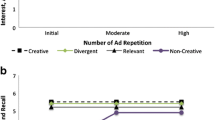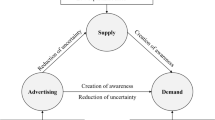Abstract
Current practice of TV advertising campaign generation usually starts with a small number of concepts and ends up with a final copy on TV, a funneling process that narrows down quickly without reliably testing the ad concepts’ effectiveness in market. Is this practice optimal? Should more ad copies be generated for testing? We propose a model and evaluation procedure to improve the ad copy generation and evaluation process. We conceptualize the process as first generating a number of alternative advertising campaigns from advertising creative and production sources, screening those campaigns with some advertising pretest methodologies which have specified validity and reliability, and then picking the best campaign based upon the screening. Our method involves variability and distribution of campaign profits, which makes it possible for ad executives to take the risk of investment into consideration. As an empirical illustration, based on estimates of the variability of profitability of alternative TV campaigns by a small sample of senior marketing executives for consumer products, we show a large sum of incremental profit could potentially be obtained if TV advertisers would screen alternative TV campaigns with pretests of modest reliability and validity. We also show how the pretesting community can estimate the validity and reliability of their tests.




Similar content being viewed by others
Notes
Due to the difficulty to get feedback from senior marketing executives, our illustration is based on a very small sample size (9). We acknowledge this caveat. Even though the sample size is small, the executives’ intuition as to the values of the parameters that affect the optimal strategy is fairly consistent. For this reason, we engaged in extensive sensitivity analysis to underscore the basic conclusion that too few advertising campaigns are being tested— it holds for a range of realistic settings of these parameters.
In the one-copy case, we do not deem ad testing uninformative about the ad: testing can still inform ad exposure levels and target audiences, among other things. By making this assumption, we assume those aspects are fixed.
In practice, existing in-market ad effectiveness tests such as BehaviorScan® by Information Resources, Inc. measure the difference in product sales change with different ad copies. Such sales data can easily be converted into ROI information that measures the relative effectiveness of ad campaigns. The reason why we use ROI instead of absolute measure of effectiveness is because ROI allows us to compare ad campaigns that might have been tested on different weight changes and market scales.
We relax the independence assumption in the extensions section.
The lack of uniqueness stems from integrality of k and n. As a practical matter, the number of campaigns that we would logically consider might vary from k = 1, …, 10. Taking the objective into consideration, we would try each of these values and find the best n. For argument sake, say that k = 7 produces the highest value for E(Profit). Since we do not know the exact values for F and v in practice, it might make sense to choose a smaller value of k, say 5, if the difference in the objective from k = 7 to k = 5 is not material.
More details on how we choose the values of σ C , F, and v are discussed in the next section.
Both the values of reliability R and validity ρ are set somewhat arbitrarily with middle-range numbers. We will demonstrate in the next section that the optimal solution is not very sensitive to the value of R.
Specially, for a normal distribution N(μ,σ C ) with mean μ and standard deviation σ C , the expected value of the maximum of two such normal order statistics is μ + .564σ C , where .564σ C represents the average improvement from testing. Hence to obtain σ C , we need to divide the average improvement from testing by .564. For instance, based on the survey, the best guess for the average improvement of a median brand ($500 million) is 18 %. In addition, our experts’ conservative estimates of incremental margin for most CPGs is 30 %. We take the expected improvement from testing $27.47 million (=$500 million × .18 × .3), then divide it by .564 to obtain an estimate of σ C ($48.70 million).
References
Cox J, Crang D, Vollman A (2010) When advertising Goes Digital. comScore
Gross I (1972) The creative aspects of advertising. Sloan Manage Rev 14:83–109
Holt CA, Laury SK (2002) Risk aversion and incentive effects. Working Paper
Hu Y, Lodish LM, Abba K (2007) A meta-analysis of real world TV advertising tests: a 15-year update. J Advert Res 47(3):341–353
Hu Y, Lodish LM, Abba K, Babak H (2009) An update of real-world TV advertising tests. J Advert Res 49(2):29–34
Johnson NL, Kotz S, Balakrishnan N (1994) Continuous univariate distributions, vol 1. Wiley, New York
Kahneman D, Tversky A (1979) Prospect theory: an analysis of decision under risk. Econometrica 47(2):263–292
Lodish Leonard M, Abraham Magid M, Livelsberger J, Lubetkin B, Richardson B, Stevens ME (1995) A summary of fifty-five in-market experimental estimates of the long-term effect of TV advertising. Mark Sci 14(3_supplement):G133–G140. doi:10.1287/mksc.14.3.G133
Lodish LM, Magid A, Kalmenson S, Livelsberger J, Lubetkin B, Richardson B, Stevens ME (1995) How T.V. advertising works: a meta-analysis of 389 real world split cable T.V. Advertising Experiments. J Mark Res 32(2):125–139
Loewenstein G, Prelec D (1992) Anomalies in intertemporal choice: evidence and interpretation. Q J Econ 107(2):573–597
Lukovitz K (2015) Top 100 CPG Brands' Sales, Market Share Down, Even As Overall Categories Grow. http://www.mediapost.com/publications/article/259293/top-100-cpg-brands-sales-market-share-down-even.html. Accessed January 1 2016
McFadden D (1980) Econometric models of probabilistic choice. In: Manski CF, McFadden D (eds) Structural Analysis of Discrete Data. M.I.T. Press, Cambridge
Pearson Egon S, Hartley Herman O (1976) Biometrika tables for statisticians. Biometrika Trust, Cambridge
Tellis GJ (2004) Effectiveness advertising: understanding when, how, and why advertising works. Sage Publications, Thousand Oaks
Thaler R (1980) Toward a positive theory of consumer choice. J Econ Behav Organ 1(1):39–60
The Cost of Advertising Nationally Broken Down by Medium (2014) WebpageFX. http://www.webpagefx.com/blog/business-advice/the-cost-of-advertising-nationally-broken-down-by-medium/
Vranica S (2014) Average CMO Tenure: 45 months (but that’s an improvement). Wall Street J
Worden N (2010) Advertising decline weighs on New York Times. Wall Street J
Author information
Authors and Affiliations
Corresponding author
Additional information
The authors thank Eric Bradlow and Christophe Van den Bulte for helpful comments on earlier drafts.
Electronic supplementary material
Below is the link to the electronic supplementary material.
ESM 1
(DOCX 43 kb)
Rights and permissions
About this article
Cite this article
Krieger, A., Lodish, L. & Hu, Y. An Integrated Procedure to Pretest and Select Advertising Campaigns for TV. Cust. Need. and Solut. 3, 81–93 (2016). https://doi.org/10.1007/s40547-016-0065-4
Published:
Issue Date:
DOI: https://doi.org/10.1007/s40547-016-0065-4




